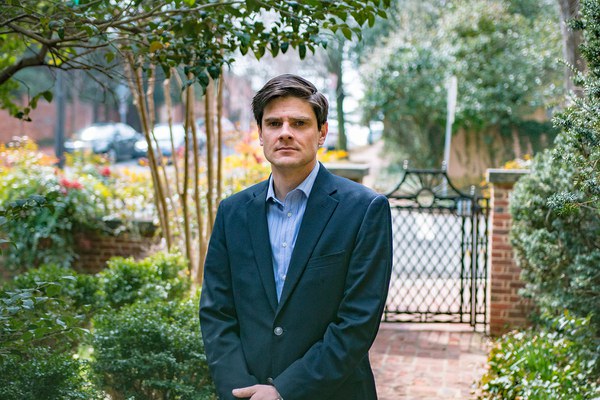Nicholas Serrano, a PhD candidate in the College of Design at North Carolina State University, is a junior fellow in Garden and Landscape Studies. His recent research report, “Garden, Nature, and Race: Landscape Architecture and Urban Development in the Post-War American South," examined the courtyard garden of Balentine’s restaurant in Raleigh, North Carolina, which was popular in the 1950s and ’60s.
Q&A with Nicholas Serrano
Balentine’s, as you described it, was a highly modern space, with mobiles hanging from the ceiling and modern art on the walls. What was Red Balentine’s background? Why did he create this modern space?
You’re referring to the initial location downtown. It was really just that he was willing to invest in that kind of thing, whereas most restaurateurs would have been more conventional—it’s a very conservative society, after all. Broadly speaking, this was an extension of the progressive New South movement; design was seen as a catalyst for cultural improvement. You see a lot of university architecture and design programs being established at this time in the South. In many ways they’re an effort to modernize the building industry itself.
Even though guests couldn’t eat in the garden, there was a great emphasis on having as little separation as possible between the garden and the actual dining area. What was the significance of that separation, or lack thereof?
Permeability between interior and exterior spaces was a main tenet of modern architecture and landscape architecture. In this particular instance, the fact that you couldn’t physically move between the dining room and garden meant it was completely visual. And once the garden becomes completely visual, you can begin to incorporate ideas from visual theory, because the space is clearly symbolic; it’s not utilitarian in any way. The point I’m trying to make is that there’s meaning in this landscape beyond just practicality, that it’s tied to the identity of the people who patronized it. The fact that it’s part of the dining room and creates an atmosphere of being half outside, but in a very aesthetic manner, is important to the environment Red Balentine was trying to create.
There were actually two restaurants, one of which, in a shopping center, featured a much more private, recessed dining area. What was the significance of that?
Well, the way I presented it in my talk was that the design of the Balentine’s in the suburbs, how it turned its back on the street, seems more than coincidental, that it was partly a reaction to the ongoing contestation of public space in the Civil Rights era. In actuality, it was coincidental, because the restaurant had to have been designed before the protests happened. But the central tenet of the design—that is, privacy—is widespread in postwar domestic architectural design. It’s just as much about creating a pure space as it is about the exclusion of others. And that, of course, is part of identity construction, defining yourself in contrast to an outside other. Whiteness is often seen as normative. I’m arguing that, in the postwar suburban landscape, whiteness was constructed in contrast to a specific visibility of black civic agency in public space.
When black students were arrested for protesting at Cameron Village, it was because this was technically a privately owned space, and the management company asked them to leave. But there’d actually been a recent Supreme Court ruling on a case in Alabama essentially saying that if a business owner opens up their space for public use, like in a shopping center, then they’re inherently giving up some rights to privacy. So eventually the black students were allowed back into Cameron Village, on the condition that they had to use the space as it was designed to be used. And that’s interesting, because it gives the designer and the role of authorial intent a lot more meaning than it’s traditionally been accorded. Once buildings are built, you don’t really control what happens there. It’s a slight theoretical shift that I don’t think has been looked at as much as it deserves.

